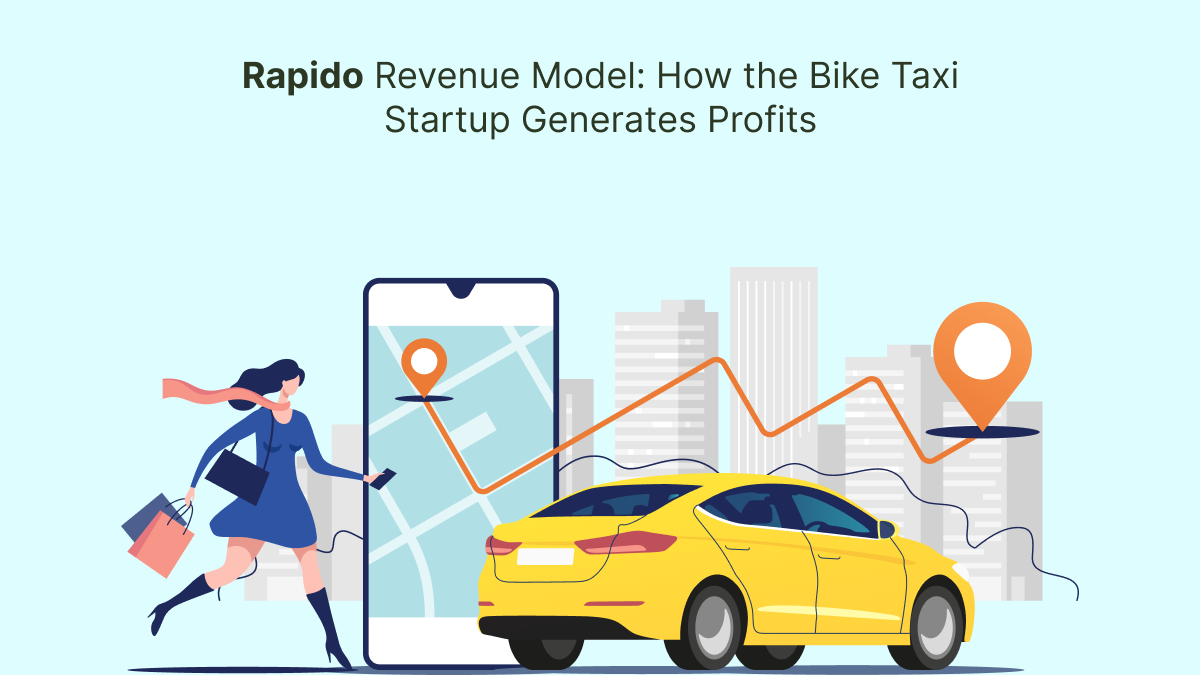The Rapido revenue model has redefined how people in India commute daily. As one of the fastest-growing bike taxi startups, Rapido focuses on providing affordable, fast, and convenient rides for users who need quick transportation in busy cities. By using an asset-light and commission-based structure, Rapido has created a profitable business model that benefits both riders and drivers. This article explores how Rapido makes money, the strategies behind its growth, and how startups can adopt similar models to build successful businesses.
What is Rapido and How It Works
Rapido was launched in 2015 to solve the urban commuting problem faced by millions of Indians. It offers two-wheeler rides that are faster and cheaper than traditional cabs or autos. Users can book a bike ride through the mobile app, and a nearby driver, known as a “Captain,” accepts the request and completes the trip. Rapido’s main goal is to provide cost-effective and time-saving transportation while also offering earning opportunities for bike owners. This simple yet effective business model has helped Rapido grow rapidly in India’s competitive on-demand transport sector.
Understanding the Rapido Revenue Model
The Rapido revenue model is designed to balance affordability for customers and profitability for the company. It follows an aggregator-based structure similar to Ola or Uber, where the platform connects riders with drivers. Rapido earns a commission on every completed ride while the driver retains the rest as income. The app handles the entire process — from ride booking and tracking to payment processing and feedback. This scalable model allows Rapido to expand across multiple cities without owning vehicles or spending heavily on infrastructure.
Key Sources of Revenue for Rapido
Commission from Rides
The main source of income for Rapido comes from the commission it charges on each ride. For every trip completed through the app, a certain percentage of the fare goes to Rapido while the rest is paid to the driver. This ensures a consistent and sustainable income flow for the platform.
Surge Pricing
Rapido uses dynamic pricing during peak hours, bad weather, or high-demand situations. Surge pricing helps maintain a balance between demand and driver availability while increasing the company’s profit margins. It’s an effective way to motivate more captains to stay active during busy hours.
Brand Partnerships and Advertising
Rapido collaborates with various brands to promote advertisements through its app and captain branding. Businesses often advertise their offers on the Rapido platform, helping Rapido earn additional income while increasing visibility for partners.
Delivery and Logistics Services
Beyond passenger rides, Rapido has entered the logistics and delivery space by partnering with e-commerce and food delivery companies. This diversification helps the company tap into the growing last-mile delivery market and generate extra revenue.
Subscription Programs for Captains
Rapido also offers subscription plans where captains can pay a small fee to access benefits like reduced commissions or priority bookings. This improves driver loyalty and creates an additional steady revenue source.
Cost Structure of Rapido
Rapido follows a lean, asset-light cost structure. The company doesn’t own any vehicles, reducing its operational expenses significantly. Its major costs include technology development, app maintenance, customer support, marketing campaigns, and incentives for captains. This structure allows Rapido to stay profitable while expanding to new regions efficiently.
Read More: Rapido Business Model: How Rapido Harnesses the Power of Motorbikes
Technology Behind Rapido’s Success
Technology plays a central role in Rapido’s success. The platform uses GPS-based algorithms to connect nearby riders and captains quickly, minimizing waiting time. AI and data analytics help predict demand, optimize routes, and manage dynamic pricing. Features like real-time tracking, cashless payments, and user feedback improve convenience and trust, making the Rapido app both efficient and customer-friendly.
Marketing and Growth Strategy
Rapido’s marketing strategy focuses on affordability, availability, and customer satisfaction. It uses regional advertising, referral programs, and discount offers to attract users. The brand also provides performance-based incentives to captains, ensuring high driver retention. By promoting convenience and cost efficiency, Rapido has successfully positioned itself as the go-to option for daily commuters across Indian cities.
Challenges Faced by Rapido
Despite its success, Rapido faces challenges such as regulatory hurdles, competition from major ride-hailing apps, and the need to maintain service quality across different cities. Local transport laws and varying regional conditions sometimes affect operations. However, Rapido’s adaptability, customer-focused service, and tech-driven approach have helped it maintain steady growth and overcome industry challenges.

Future of Rapido’s Business Model
The future looks bright for Rapido as it continues to expand its service portfolio. The company’s focus on sustainable transport options, such as electric bikes and delivery solutions, indicates a shift toward eco-friendly mobility. As urban populations grow, Rapido’s ability to scale and innovate will determine its long-term profitability. Startups looking to replicate this model can explore building similar on-demand mobility platforms tailored to their markets.
Conclusion
Rapido’s success lies in its smart and sustainable business strategy. The Rapido revenue model, built on commission-based operations and low asset dependency, ensures consistent profits and growth. Its focus on technology, affordability, and customer satisfaction has set a new benchmark in India’s on-demand mobility sector. Startups and enterprises aiming to enter this space can learn from Rapido’s approach and implement similar strategies to achieve long-term success. For those looking to expand further, exploring opportunities with a gojek clone app can help build a multi-service platform that goes beyond bike rides and delivers multiple on-demand solutions under one app.
FAQs
How does Rapido make money?
Rapido makes money mainly through commissions on rides, surge pricing during peak hours, advertising partnerships, and delivery collaborations.
Does Rapido own any vehicles?
No, Rapido follows an asset-light model. All bikes are owned by individual captains who register on the platform to offer rides.
What makes Rapido’s revenue model different?
Rapido’s model focuses on two-wheelers, which provide faster, cheaper rides and higher ride frequency compared to traditional cab services.
How does Rapido keep costs low?
Rapido reduces expenses by not owning vehicles and using technology-driven processes for ride matching, payments, and tracking.
Can startups build a similar app like Rapido?
Yes, startups can develop their own bike taxi app using a pre-built or custom gojek clone app to enter the on-demand transportation market quickly and efficiently.





